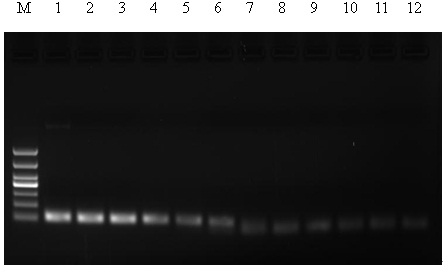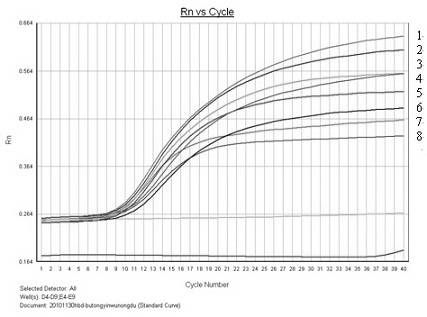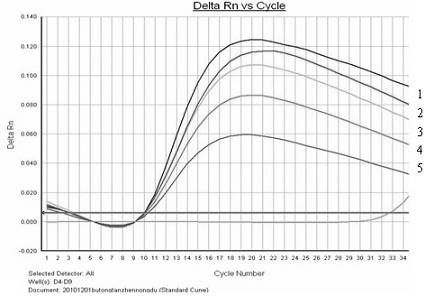Fluorescence quantitative RT-PCR (reverse transcription-polymerase chain reaction) kit for rapidly detecting XHF (Xinjiang hemorrhagic fever) viruses
An RT-PCR, hemorrhagic fever virus technology, applied in the field of fluorescence quantitative RT-PCR kits, can solve the problems of non-application, long identification time, delayed positive reaction, etc., to ensure accuracy and specificity, and the detection process is convenient. Fast, accurate results
- Summary
- Abstract
- Description
- Claims
- Application Information
AI Technical Summary
Problems solved by technology
Method used
Image
Examples
Embodiment 1
[0039] Example 1: Preparation of positive control RNA template
[0040] According to the sequence of Xinjiang hemorrhagic fever virus (GenBank sequence number: HQ833035.1), a DNA fragment with a size of 606 bp containing the fluorescent RT-PCR detection fragment sequence was amplified, cloned into the PMD-18T vector, and purified with a plasmid DNA extraction kit Plasmid DNA, sequenced to confirm the orientation of the insert. Use universal primers paired with the vector to amplify the T7 promoter and the inserted Xinjiang hemorrhagic fever virus sequence, then use MAXIscript T7 Kit for in vitro transcription to generate target RNA, and then use TURBO DNase for DNase treatment to remove untranscribed PCR amplification. Increase the template, and finally use ethanol precipitation to purify the RNA product, which is the positive control RNA template, and is stored in a -80 °C ultra-low temperature refrigerator for later use.
[0041] Take 1 μL of in vitro transcribed template R...
Embodiment 2
[0043] Example 2: Determination of Amplification Procedures
[0044] The RT-PCR reaction kit was AgPath-ID? One-Step RT-PCR Kit (product of Ambion Company, USA), and the amplification and detection were carried out on ABI7500 real-time fluorescence quantitative PCR instrument.
[0045]According to the specific characteristics of primers and probes, the reaction program on the instrument tested 3 temperatures and 2 times in the selection of annealing extension conditions: 10 minutes at 45°C, 15 minutes at 95°C, and 40 PCR cycles: 15 minutes at 95°C seconds → (58 / 60 / 62) °C (30 / 45) seconds; the sample volume of each reagent is 1 μl of 25×RT-PCR enzyme mixture in each reaction tube, 2×RT-PCR reaction 12.5 μl buffer, 1 μl forward primer, 1 μl reverse primer, 0.5 μl fluorescent probe, 100 pg to 1 μg (≤ 10 μl) of template RNA, made up to a total volume of 25 μl with DEPC-treated water, and the fluorescence signal acquisition was set in the annealing extension stage . Positive ampli...
Embodiment 3
[0046] Embodiment 3: Determination of optimal primer concentration
[0047] When the final concentration of the probe was 250nM, the amplification test was carried out respectively by eight groups of forward and reverse primer concentrations listed in Table 2, and the amplification curve was obtained as a result of the test. figure 1 . from figure 1 Select the curve with the smallest Ct value and a more obvious amplification curve ( figure 1 The primer concentration corresponding to the third curve in ) is the optimal concentration, that is, the final concentration of the forward primer is 500nM, and the final concentration of the reverse primer is 750nM.
[0048] Table 2
[0049] group XHFV-FP / RP (final concentration nM) Ct value 1 750 / 500 13.25 2 750 / 250 13.57 3 500 / 750 13.18 4 500 / 500 13.34 5 500 / 250 13.71 6 250 / 750 13.66 7 250 / 500 13.27 8 250 / 250 13.65
PUM
 Login to View More
Login to View More Abstract
Description
Claims
Application Information
 Login to View More
Login to View More - R&D
- Intellectual Property
- Life Sciences
- Materials
- Tech Scout
- Unparalleled Data Quality
- Higher Quality Content
- 60% Fewer Hallucinations
Browse by: Latest US Patents, China's latest patents, Technical Efficacy Thesaurus, Application Domain, Technology Topic, Popular Technical Reports.
© 2025 PatSnap. All rights reserved.Legal|Privacy policy|Modern Slavery Act Transparency Statement|Sitemap|About US| Contact US: help@patsnap.com



